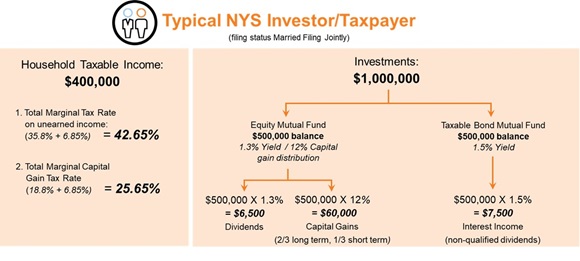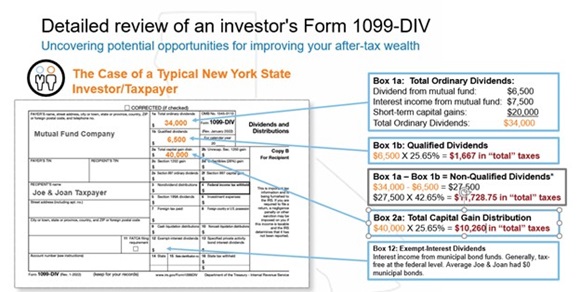New York, New York – If you can make it there, you’ll pay those taxes!
After recently attending an International Auto Show event, we were amazed to see the great variety of choices we have in vehicles now. There’s a lot of buzz about electric vs. combustion engines, but there have been many other advances as well. Cars are now available in all sizes—there are CUVs, SUVs, trucks and more—and they come powered with gas, diesel, electric … and other fuel types are being developed. It is clear we have many different options as consumers for what we choose to drive from point A to point B. For some of us, it’s about a luxury ride, for others it’s about speed and performance, and for many it’s about utility and the focus on arriving safely at the chosen destination.
Similarly, the choices investors make with their investments are about going from point A to point B, with the journey ending for most people at a comfortable retirement. There are many ways to invest and many investments to choose. Just as there are different types of vehicles to get you physically from one point to another, there are many types of investments to get you financially from point A to B. Just like their choice of mode of transportation, it’s about how the individual wants to experience the investment journey: is it about luxury, is it about speed and performance, is it focused on creating the smoothest path to get to retirement? But in all of this, what about the consideration of taxes? And even more so, about the impact of state taxes if your choices have taken you to a high-tax locale?
Where we choose to live is … a choice. This choice was probably driven by specific factors: employment, lifestyle or family. But when it comes to saving and investing for retirement, the state tax rate needs to be considered.Taxes can have an outsized impact on savings, one that you may not notice until it’s too late. When we drive our cars, we don’t accelerate while keeping our foot on the brake … this would create unnecessary drag. In the same way, taxes are a drag on returns and investment results. Let’s look at how much drag is being created by taxes at both the federal and state level in one of the highest-tax states: New York.
NY state taxes: What you need to know
There are a couple of things you need to know about how your state’s tax rate can impact your portfolio and after-tax return.
- State income tax rates scale up at a faster pace than federal taxes. This means you could reach one of the higher state tax rate brackets at a much lower income level than federal taxes.
- In New York state, capital gains aren’t given preferential treatment. That means most investment income is taxed as ordinary income.
- State taxes are only deductible up to a maximum of $10,000 a year from your federal tax return. That means there is a very good chance that your real estate taxes have used most, if not all, of the benefit; and you may have very little to no ability to deduct state income taxes from your federal taxes.
Notice how quickly one’s income level pushes a taxpayer into relatively high tax rates?
Does New York tax investment income?
This is a good question—what is causing these taxes? The short answer is your income plus the distributions from your investments.
The long answer isn’t that much more complicated. Tax-exempt bond interest is exempt from taxes at the federal level but not necessarily at the state level. Only tax-exempt bonds from your specific state get the tax-exempt benefit when it comes to state income taxes. Additionally, while at the federal level qualified dividends and long-term capital gains receive preferential tax treatment, they don’t at the state level in New York. Interest, dividends and realized capital gains are taxed as ordinary income.
Let’s look at a specific albeit hypothetical scenario: a married couple filing jointly in the latter part of their working years with a combined income of $400K. Let’s assume our fictional couple, Joe and Joan, have a portfolio with a value of $1 million, split evenly between stocks and bonds in order to keep the math somewhat simple. Using some averages from last year, we can look hypothetically at how much income their portfolio created. You can also see what their marginal combined tax rates look like.
Click image to enlarge

For illustrative purposes only. Tax rates used at $400K income level for married filing jointly: 35% Federal income tax rate, 3.8% Net Investment Income Tax (NIIT), 15% capital gains rate, and 6.85% New York State income tax rate.
This information doesn’t mean much unless we look at the cost to the taxpayer. From here we go to the Form 1099-DIV, which is something many investors may receive each year around February or March:
Click image to enlarge

For illustrative purposes only. Tax rates used at $400K income level for married filing jointly: 35% Federal income tax rate, 3.8% Net Investment Income Tax (NIIT), 15% capital gains rate, and 6.85% New York State income tax rate. *Any non-qualified dividends are taxed at ordinary income at 35.8%.
This is what the 1099-DIV looks like for this hypothetical investment couple. To make sense of the picture, stay tuned. But while we are on the 1099-DIV, we added in some calculations on the right as well as highlighted the most important boxes investors should look at. This is a case where knowledge is power, but we also need a calculator.
In the end, what matters most is how much your state tax rate costs you. And, how much of your investment return is lost to tax drag (tax drag = tax cost and tax cost is basically a hidden fee) (financial professional login required).
For illustrative purposes only. Tax rates used at $400K income level for married filing jointly: 35% Federal income tax rate, 3.8% Net Investment Income Tax (NIIT), 15% capital gains rate, and 6.85% New York State income tax rate.
Ouch. As if the cost of taxes at the federal level wasn’t enough.
In summary, this 50/50 portfolio lost almost 2% of return to the cost of federal taxes. When you add in the tax drag created by state taxes, the impact increases to nearly 2.5%. It’s true that federal taxes are still the biggest bite out of your return, but the state tax impact is not negligible. A full half a percent lost to taxes is a big deal, especially when you consider the long-term impact of compounding that lost return.
You better pay attention to state taxes, too!
Taxes are a cost. While many investors primarily think about income as the source of their tax liability, tax drag can also come from interest, dividends and capital gains. And taxes from both the federal and state levels can nip at your investment return. This is why tax management is important at every level. The more that can be done to control the drag that taxes have on your investment return, the more likely you are to achieve your financial goals.

